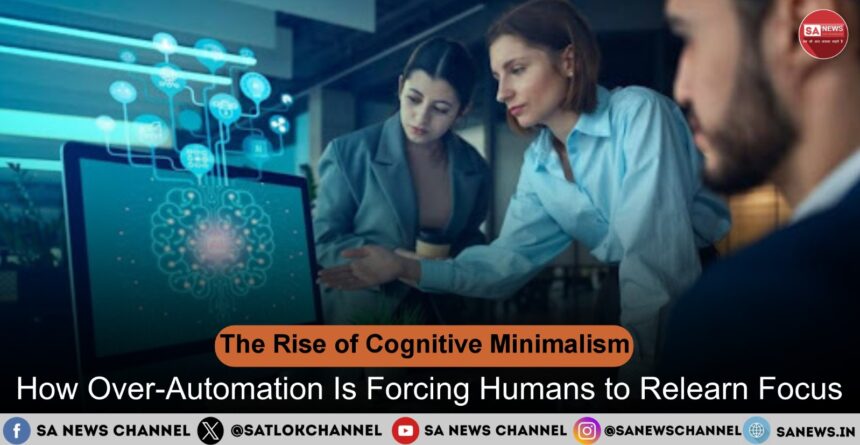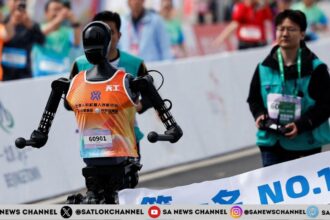Do you find yourself checking your phone every few minutes, even when you’re trying to concentrate on a single task? You are not alone. In our hyper-automated, digitally saturated world, the constant stream of notifications, emails, and automated processes is fundamentally rewiring our brains. This has led to a growing crisis of attention, where deep, sustained focus is becoming a rare and valuable commodity. This dramatic decline signals something profound: we’re experiencing a collective crisis of focus that’s reshaping how we think, work, and live.
- Understanding Cognitive Minimalism in the Digital Age
- The Hidden Cost of Over-Automation
- Digital Minimalism as a Response to Tech Overload
- The Attention Economy’s Breaking Point
- Practical Strategies for Cultivating Cognitive Minimalism
- The Psychology of Relearning Focus
- Future-Proofing Your Attention
- Industry-Specific Applications
- Healthcare and Cognitive Minimalism
- Education’s Attention Revolution
- Creative Industries and Deep Work
- From Mental Clarity to Spiritual Awakening
The rise of cognitive minimalism represents a crucial response to this crisis. As our digital environments become increasingly automated and attention-fragmenting, millions are discovering that less truly is more when it comes to mental clarity. This philosophical and practical approach to managing our cognitive resources isn’t just another productivity trend—it’s becoming essential for maintaining mental health in the automation era.
This comprehensive guide explores how over-automation is paradoxically forcing us to relearn focus in the automation era, why traditional approaches to productivity are failing, and how cognitive minimalism offers a path forward. We’ll examine the science behind attention fragmentation, the hidden costs of automation overload, and practical strategies for reclaiming your mental bandwidth.
Understanding Cognitive Minimalism in the Digital Age
What Is Cognitive Minimalism?
At its core, minimalism is about stripping away the non-essential, fostering an environment that promotes simplicity, clarity, and purpose. But beyond its aesthetic and lifestyle benefits, minimalism harbours profound implications for our cognitive health and well-being. Cognitive minimalism extends these principles to our mental landscape, focusing on how we process information, make decisions, and allocate our attention in an increasingly complex world.
Unlike digital detoxes that advocate complete disconnection, cognitive minimalism takes a more nuanced approach. Digital minimalism isn’t about abandoning technology—it’s about using it intentionally. Coined by computer science professor Cal Newport, it’s defined as “a philosophy of technology use in which you focus your online time on a small number of carefully selected and optimized activities that strongly support things you value”.
The philosophy recognises that in our hyper-automated world, the challenge isn’t avoiding technology but developing a healthier relationship with it. This means creating intentional friction where automated systems have removed it, establishing boundaries where algorithms blur them, and choosing depth over surface-level engagement that automation often encourages.
The Science Behind Mental Decluttering
Numerous studies have demonstrated a clear link between the organisation of physical space and cognitive performance. But cognitive minimalism goes deeper than organising your desk or decluttering your home. It addresses the invisible clutter that accumulates in our minds from constant digital stimulation.
Research from the University of California shows that it takes an average of 23 minutes to fully regain focus after a single interruption. With dozens of daily disruptions, we’re operating at a fraction of our potential [University of California, 2024]. This cognitive switching penalty compounds throughout the day, creating what researchers call “attention residue”—fragments of focus left behind on previous tasks that prevent full engagement with current ones.
The benefits of cognitive minimalism become clear when we understand how our brains process information. Your brain has finite resources. Every notification, email, and task switch depletes your mental energy. Studies from Stanford University demonstrate that heavy multitaskers actually perform worse at attention and memory tasks compared to those who focus on one thing at a time.
The Hidden Cost of Over-Automation
When Convenience Becomes Cognitive Overload
The promise of automation was simple: machines would handle repetitive tasks, freeing humans for creative and strategic work. Yet radiologists consistently using AI were 39% more likely to experience burnout than those who didn’t. The odds of burnout rose in proportion to the frequency of AI use, suggesting that constant reliance on AI may exacerbate emotional exhaustion.
This paradox reveals a fundamental misunderstanding about human cognition. Over-automation effects on attention manifest in several ways:
Increased Complexity: While AI automates repetitive tasks, it can also create more complex workflows. Workers are required to monitor, oversee, and sometimes correct AI systems, adding layers of responsibility rather than reducing them.
Digital Debt Accumulation: Nathan Whittacre defines “digital debt” as the accumulation of non-core tasks—like responding to emails, attending meetings, and managing notifications—that detract from an employee’s primary job responsibilities. This phenomenon not only leads to frustration but also prevents employees from achieving their professional goals
Context Switching Overload: Context switching is the primary reason your productivity is so low, thanks to disconnected systems that drain the mental energy of your teams. These tools only create more complexity and headaches because your team members spend all their time navigating and context switching [DuploCloud, 2025].
The Automation Paradox in Modern Workplaces
Burnout in the workplace reached an all-time high in 2024. Around 82% of 1,500 white-collar, desk-based knowledge workers in North America, Asia, and Europe surveyed by DHR Global reported being “slightly” to “extremely” burned out. Similarly, 39% of 2,100 global employees surveyed by Skillsoft cited burnout and exhaustion as the top challenge they experienced in 2024 [HR Brew, 2025].
The relationship between automation and burnout is complex. While automation promises efficiency, it often creates new forms of cognitive labour. Workers must now:
- Learn and adapt to constantly evolving automated systems
- Manage the outputs and errors of multiple AI tools
- Navigate between automated and manual processes
- Maintain human judgment while relying on machine recommendations
This creates what experts call “automation sprawl”—a proliferation of disconnected automated tools that fragment rather than focus attention. Exploring our internal guide on automation fatigue solutions reveals how organisations are beginning to address this challenge.
Digital Minimalism as a Response to Tech Overload
The Movement Gaining Momentum
The science behind digital minimalism is compelling. Dr. Adam Gazzaley, Professor of Neurology at UCSF and director of the Neuroscape Laboratory, explains: “Our brains simply weren’t designed to process the volume of information and decisions that modern digital life demands of us.” His research demonstrates how constant digital stimulation affects the prefrontal cortex—the brain region responsible for executive functions like decision-making and emotional regulation. The practice of digital minimalism directly counteracts these negative effects by reducing what neuroscientists call “cognitive load” [Baizaar.tools, 2025].
The movement is attracting diverse practitioners, from Silicon Valley executives to healthcare workers experiencing automation burnout. Sarah Chen, a software developer in Seattle, implemented digital minimalism and saw her productivity increase by 40% within two months.
Real-World Success Stories
Consider the transformation documented in recent case studies. Meet Lena, a UX designer in Berlin. In 2023, she was drowning in productivity tools. She used Trello for task management, Google Calendar for time-blocking, Slack for team chats, Notion for note-taking, and Toggl for tracking time. She was working 10-hour days but felt like she was getting nothing truly important done. That changed in mid-2024, when Lena embraced AI-driven digital minimalism.
These stories highlight a crucial insight: cognitive minimalism isn’t about rejecting technology but about strategic reduction and intentional use. Practitioners report gaining 2–3 hours per day. That’s an extra 730–1095 hours per year to invest in your goals, relationships, and personal growth.
The Attention Economy’s Breaking Point
Statistical Reality Check
The numbers paint a sobering picture of our collective attention crisis:
- Individuals now check their phones an average of 58 times per day globally. This constant checking contributes to fragmented attention, reducing the ability to concentrate on a single task effectively [ConsumerAffairs, 2025].
- Research shows that switching between tasks comes with a significant time penalty, requiring an average of 23-25 minutes to regain focus after an interruption [University of California, 2008].
These statistics reveal how digital distractions and focus have become inversely related. The more connected we become, the less able we are to sustain deep attention on any single task.
The Multi-Screen Generation
People in the 16–24 age group engage with an average of six screens at once, further fragmenting attention spans. This multi-screen behaviour isn’t just changing how we consume information—it’s rewiring our neural pathways.
Professor Gloria Mark analysed the attention spans of people while interacting with screens. In 2004, a human paid, on average, 2.5 minutes of attention when connected to a device. Today, that number has dropped to just 47 seconds [University of California + Microsoft Research, 2004].
Practical Strategies for Cultivating Cognitive Minimalism
Building Your Minimalist Framework
Creating a cognitive minimalism practice requires both environmental design and behavioural change.
1. Audit Your Digital Environment
Start by mapping your current digital landscape. Track:
- How many apps you actively use daily
- Number of notifications received per hour
- Time spent context-switching between tools
- Automated processes that require your oversight
2. Implement Strategic Friction
The goal of digital minimalism software is to counteract that design. It creates friction where there was none, forcing a moment of pause between you and the distraction.
Add intentional barriers to automated behaviours:
- Turn off auto-play features
- Disable push notifications for non-essential apps
- Use website blockers during focused work periods
- Set specific times for checking automated reports
3. Practice Attention Restoration
If you want to get things done, work. If you want to get the right things done, rest. Rest is a necessity for creative work—the type of work that actually leads to a good life. It’s counterintuitive, but rest is how you get six years of work done in six months [Dan Koe, 2024].
Build regular practices that restore cognitive capacity:
- Schedule “boredom blocks” with no stimulation
- Practice single-tasking for extended periods
- Engage in activities that promote mindfulness and attention span
- Take regular digital sabbaticals
Technology Tools That Support Minimalism
Paradoxically, some technology can help us achieve cognitive minimalism:
Focus-Oriented Browsers: Arc rethinks the browser from the ground up. It encourages a “tidy tab” mentality by automatically archiving tabs you haven’t used. Its clean, spatial interface and focus on shortcuts reduce visual noise and mouse-driven wandering
Minimalist Search Engines: Using a search engine like DuckDuckGo, which prioritises privacy and delivers clean, non-personalised results, can short-circuit the rabbit-hole effect. You get the answer you need without the algorithm trying to predict—and hijack—your next three hours
AI-Driven Prioritisation: Rather than adding complexity, well-designed AI can reduce cognitive load by handling routine decisions and filtering information based on your defined priorities.
The Psychology of Relearning Focus
Neuroplasticity and Attention Recovery
The good news about our attention crisis is that the brain’s neuroplasticity means we can relearn focus in the automation era. Social media and endless scrolling hijack your brain’s reward system, creating addictive patterns that make deep work increasingly difficult. Digital minimalism helps reset these neural pathways, making it easier to focus on meaningful tasks.
Research shows that consistent practice of focused attention can:
- Strengthen prefrontal cortex function
- Improve working memory capacity
- Enhance cognitive flexibility
- Reduce susceptibility to distraction
Overcoming Digital FOMO
Fear of Missing Out (FOMO) represents one of the biggest psychological barriers to adopting cognitive minimalism. However, practitioners report discovering something unexpected: replace social media FOMO with JOMO (Joy of Missing Out). Focus on creating experiences rather than consuming them.
Also Read: Larry Page: The Visionary Mind That Built Google and Transformed the Digital World
This shift from consumption to creation represents a fundamental reorientation of how we engage with technology. Instead of being passive recipients of automated content streams, cognitive minimalists become intentional creators and curators of their digital experiences.
Future-Proofing Your Attention
The Evolution of Cognitive Minimalism
As we look toward the future, cognitive minimalism is evolving from individual practice to organisational philosophy. With AI handling the routine, repetitive, and reactive—digital minimalists finally get to focus on the meaningful, creative, and strategic.
Forward-thinking companies are beginning to implement cognitive minimalism principles at scale:
- Creating “deep work” zones free from digital interruption
- Limiting the number of communication channels
- Establishing clear boundaries around automated processes
- Prioritising human judgment over algorithmic recommendations
Preparing for an Even More Automated World
With the entry-level turning into the senior-level thanks to AI and automation, technicians will be replaced, or they will be forced to become creators. Technicians work toward assigned goals; creators cultivate a lifestyle that naturally results in the goals they choose [Dan Koe, 2024].
This shift requires developing new cognitive skills:
- Meta-learning: Learning how to learn in rapidly changing environments
- Attention management: Treating focus as a valuable resource to be invested wisely
- Cognitive flexibility: Moving fluidly between automated and human-centred thinking
- Deep work capacity: Sustaining focus on complex, creative tasks
Industry-Specific Applications
Healthcare and Cognitive Minimalism
The healthcare sector provides a compelling case study for cognitive minimalism implementation. In healthcare, AI is transforming diagnostics and patient care, but the pressure on professionals to quickly integrate these tools into workflows can amplify burnout. A 2024 study found that radiologists consistently using AI were 39% more likely to experience burnout than those who didn’t [The Muse, 2024].
Healthcare organisations are responding by:
- Limiting the number of diagnostic AI tools per department
- Creating “analog rounds” where doctors focus solely on patient interaction
- Implementing structured breaks from screen-based work
- Designing workflows that balance automated and manual processes
Education’s Attention Revolution
Educational institutions are at the forefront of addressing attention challenges. The average attention span of a student is 10–15 minutes. Students’ attention levels drop after 10–30 minutes of a lecture. High school students are off-task 17% of the time during lectures [Gitnux, 2024].
Innovative approaches include:
- Chunking lessons into focused 10-minute segments
- Incorporating movement and hands-on activities
- Using technology strategically rather than constantly
- Teaching attention training techniques as core curriculum
Creative Industries and Deep Work
Minimalist design is highly effective in enhancing user engagement by eliminating distractions and focusing on the core content. Users are more likely to interact with a design that is straightforward and easy to navigate. This approach also reduces cognitive load, making it easier for users to process information and take action.
Creative professionals are pioneering cognitive minimalism through:
- Batch processing creative work
- Establishing “maker time” versus “manager time”
- Using analog tools for ideation phases
- Creating distraction-free creative spaces
From Mental Clarity to Spiritual Awakening
Cognitive minimalism begins as a method for reclaiming attention but culminates in something far greater—the rediscovery of inner stillness. When the noise of automation fades, what remains is the silent awareness that perceives beyond thought, the essence that technology can never replicate. True focus is not merely mental discipline; it’s the alignment of mind and spirit with a higher purpose. As we simplify our cognitive lives, we naturally begin to question what truly deserves our attention. This journey of clarity can open the door to spiritual understanding, beautifully explored in “Gyan Ganga” and “Way of Living” by Saint Rampal Ji Maharaj—works that illuminate the path toward authentic worship and a life anchored in divine truth.









